
May take a minute to load the many images!
Organic Evolution in terms of the Implicate and Explicate Orders.
Part LXXb
Diptera (midges, mosquitoes, flies) (IIb)
The evolutionary diversification in the Order Diptera revisited.
Venational derivational lines and morphoklines in Bibionomorpha (Sequel)
Entering now the cladistic structure (i.e. genealogic structure according to Phylogenetic Systematics) of the Fungivoriformia, which group, as a supposed monophyletic unity, forms the chief component of Bibionomorpha, it is wise to first give an overview of this large and diverse group :
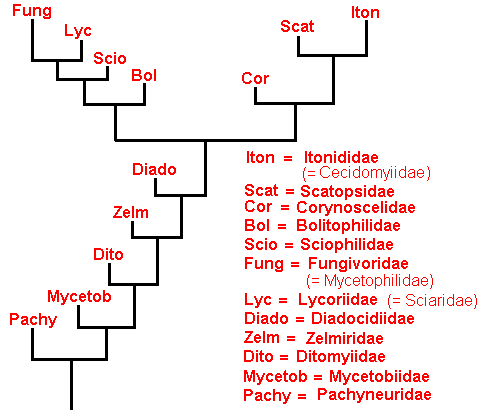
Overview of phylogenetic system of the recent Fungivoriformia.
The group of true Fungivoriformia (i.e. the Fungivoriformia minus the mesozoic Parafungiformia) consists of three series, viz., the basic series and two terminal series.
Basic series :
For the recent families in this diagram, press their names :
Pachyneuridae Mycetobiidae Ditomyiidae Zelmiridae Diadocidiidae
To see the fossils, press their names :
Rhaetomyia necopinata Paraxymyia Pleciomimella Pleciomima Mimallactoneura Lycoriomimodes Eoboletina
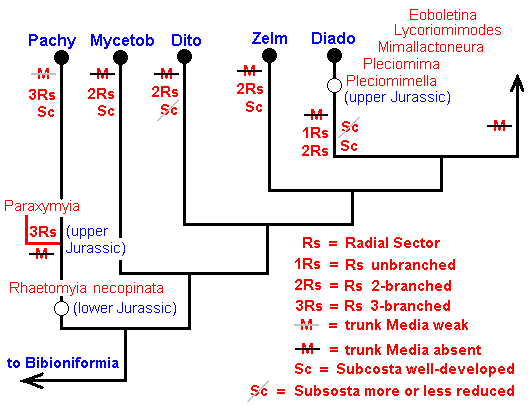
Figure 53 : Phylogenetic tree of the basic series of true Fungivoriformia with fossils included.
First terminal series :
Recent : Lycoriidae Fungivoridae Sciophilidae Sciophilidae Bolitophilidae Diadocidiidae
Fossil : Transversiplecia Pleciofungivora Mesosciophilodes (1) Mesosciophilodes (2) Mesosciophila Paritonida
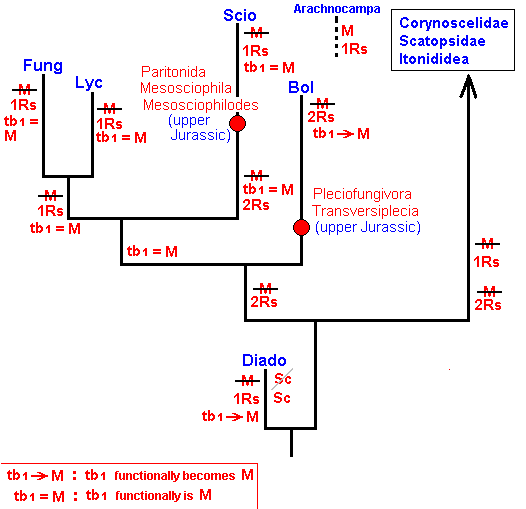
Figure 55 : Phylogenetic tree of the first terminal series of fungivoriformian families with mesozoic fossils.
Second terminal series :
Diadocidiidae Corynoscelidae Scatopsidae Lestremiidae Itonididae .
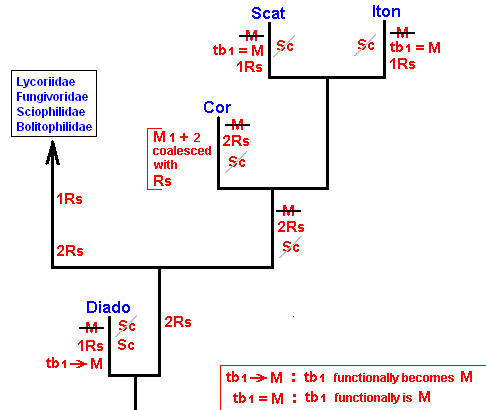
Figure 61 : Phylogenetic tree of the second terminal series of fungivoriformian families (Corynoscelidae, Scatopsidae, Itonididea [= Lestremiidae + Itonididae] ).
xRs = Radial Sector with x branches. M = basal trunk of Media present (when scored through, it means : basal trunk of Media absent). Sc = Subcosta present (scored through with a brown score means that it has partly been reduced). For the abbreviations of the family names see Figure above .
Having showed the taxonomic structure, i.e. the cladistics, of the Fungivoriformia according to the monophyletic theory of evolution (and based on wing-venation), we will now investigate the venational derivational lines (again numbering them from 1 onwards) and their corresponding diagrams of morphoklines, showing the polyphyletic evolution of the Fungivoriformia and with them that of the Bibionomorpha as a whole.
Derivational Line 1 (basic series + first terminal series of the true Fungivoriformia)
( Without indication of geologic age : representative of recent fauna) (see for the original configuration of the Medial-Cubital region in Bibionomorpha HERE ) ( We begin this Line with some uncertain but interesting venations):
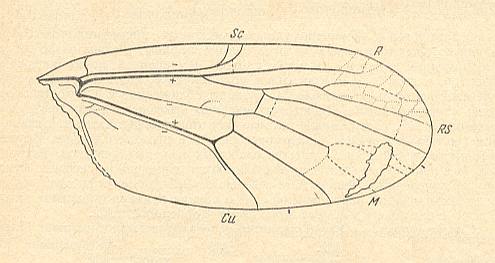
|
Rhaetomyia necopinata. Lower Jurassic of Issyc-Kul, central Asia.
Rhaetomyiidae.
Length 3.44 mm. Radial Sector (RS) 3-branched. Probably M1, M2, and certainly M4, present. Discoidal cell absent.
Cross-veins ta [= r-m] and tb2 [= m-cu] present.
Although the venation of this form approaches that of Pachyneura, it is not certain whether this form indeed belongs to the Bibionomorpha at all.
|
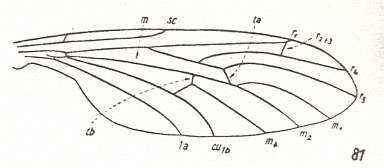
|
Axymyia furcata. Axymyiidae.
Radial Sector (RS) 3-branched. M1, M2, and M4, present. Discoidal cell absent.
The basal trunk of the Media seems well developed.
Cross-veins ta [= r-m] and tb2 [= m-cu] present.
1A present as a complete vein (in contrast to Rhaetomyia.
|
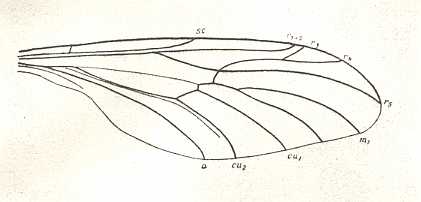
|
Pachyneura fasciata. Pachyneuridae.
Radial Sector (RS) 3-branched. M1, M2, and M4, present. Discoidal cell absent.
Medial trunk present, but presumably weak (initiating its disappearance).
Cross-veins ta [= r-m] and tb2 [= m-cu] present.
1A present as a complete vein (in contrast to Rhaetomyia.
|
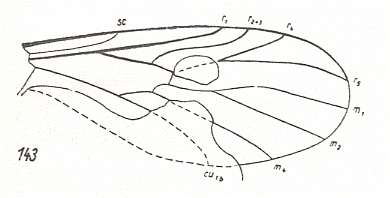
|
Paraxymyia quadriradialis. Upper Jurassic of Karatau, southern Kazachstan. Length 2.25 mm.
Paraxymyiidae.
Radial Sector (RS) 3-branched, but differently so as it is in Rhaetomyia Axymyia and Pachyneura. It is branched as in the Liassic Eoplecia
M1, M2, and M4, present. Discoidal cell absent. Medial trunk absent.
Cross-veins ta [= r-m] and tb2 [= m-cu] present.
Paraxymyia is difficult, if not impossible, to fit into the present derivational sequence. But it anticipates, already from a primitive state of the Radial veins, the vanishing of the Medial trunk in the coming Fungivoriformia.
|
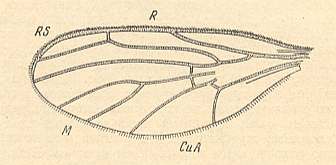
|
Perissomma fuscum. Perissommatidae.
Radial Sector (RS) 3-branched like in Pachyneura.
M1, M2, and M4, present. Discoidal cell absent. Medial trunk absent, but in a different way than it is so absent in the previous and next forms.
Cross-vein ta [= r-m] present. The vein 1A absent.
Also this form might be rather isolated, and perhaps not belonging to the present derivational sequence.
|
Entering now the basic series (s.str.) of true Fungivoriformia :

|
Mycetobia pallipes. Mycetobiidae.
Radial Sector (RS) has become 2-branched. Trunk of Media completely vanished.
M1, M2, and M4, present. Discoidal cell absent.
Cross-veins ta [= r-m], tb1 and tb2 present. The vein 1A present and reaching wing-margin.
|
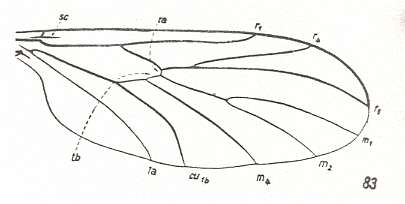
|
Ditomyia fasciata. Ditomyiidae.
Venation basically the same as in Mycetobia.
Subcosta (SC) strongly reduced.
|
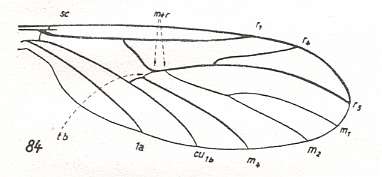
|
Ditomyia conjuncta. Ditomyiidae.
Subcosta (SC) also strongly reduced. Anterior branch of RS shortened.
Media coalesced for a short distance with RS. Therefore, ta suppressed.
While the venations of the last three species together form a true derivational sequence, viz., Mycetobia pallipes ==>, Ditomyia fasciata ==> D. conjuncta, the next venation (namely that of Macrocera lutea) cannot be a continuation of it, because it still has a full Subcosta.
|
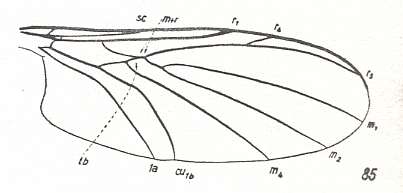
|
Macrocera lutea. Zelmiridae.
Subcosta (SC) fully developed.
Interradial field narrowed, therefore anterior branch of RS short.
Media coalesced for a very short distance with RS.
Although the venation of the present species does not formally follow upon that of the previous species, it surely belongs to the same tendency of venational change.
|
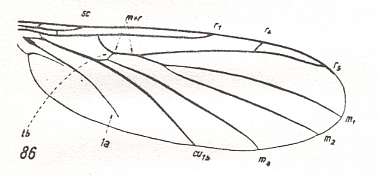
|
Zelmira fasciata. Zelmiridae.
Subcosta (SC) fully developed, but short.
Media coalesced for a longer distance with RS.
1A not reaching wing-margin.
|
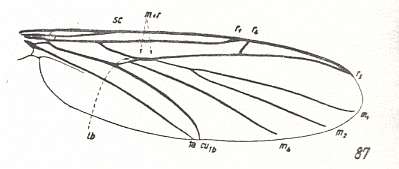
|
Allactoneura nigrifemur. Zelmiridae.
End of anterior branch of RS very close to end of R [= R1 = r1].
1A reaching wing-margin.
Because of the latter feature the venation of the present species cannot strictly be derived from that of Zelmira. And although it may be derived from the previous-previous one (Macrocera), the respective wing shapes suggest independent origin.
|
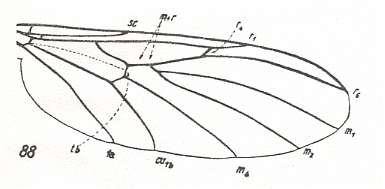
|
Apemon marginata. Zelmiridae.
Anterior branch of RS ends up in R.
1A ending up in wing-margin much behind CuA (Cu1b in the Figure).
The venation of the present species cannot strictly be derived from that of the previous one, because it is more primitive with respect to the direction of tb1 (its original orientation as being the base of M4, i.e. not recurrent).
|
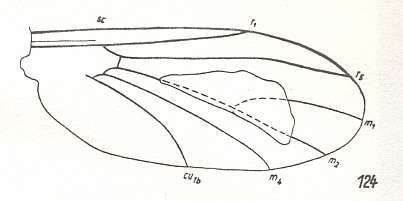
|
Pleciomimella karatavica. Pleciomimidae.
Upper Jurassic of Karatau, southern Kazachstan.
Length 2.1 mm.
Radial Sector already [i.e. already in Jurassic times] unbranched.
The basal Medial trunk has vanished. Its replacement by the cross-vein tb1 has not yet started.
The venation of this fossil species may be seen as derivable from the previous one (Apemon) : SC in a reduced state, RS has become unbranched. The vein 1A apparently vanished. But ta is not suppressed and has retained its original orientation as a true cross-vein, forbidding strict derivation.
|
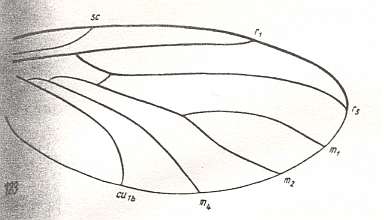
|
Pleciomima sepulta. Pleciomimidae.
Upper Jurassic of Karatau, southern Kazachstan.
Length 2.5 mm.
Radial Sector unbranched.
Replacement of Medial trunk by the cross-vein tb1 just begun. Cubital fork (CuA + M4) deep.
Although the venation of this species is very similar to that of the previous one (Pleciomimella), it cannot be derived from it because SC is more primitive.
|
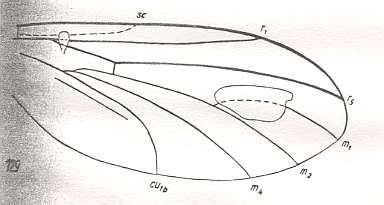
|
Mimallactoneura vetusta. Pleciomimidae.
Upper Jurassic of Karatau, southern Kazachstan.
Length 3.00 mm.
Radial Sector unbranched.
Replacement of Medial trunk by the cross-vein tb1 just begun. Cubital fork (CuA + M4) deep.
|
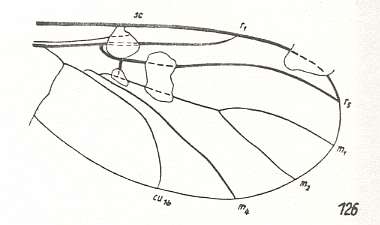
|
Lycoriomimodes deformatus. Pleciomimidae.
Upper Jurassic of Karatau, southern Kazachstan.
Length 1.6 mm.
Radial Sector unbranched.
Replacement of Medial trunk by the cross-vein tb1 just begun. Cubital fork (CuA + M4) deep.
|
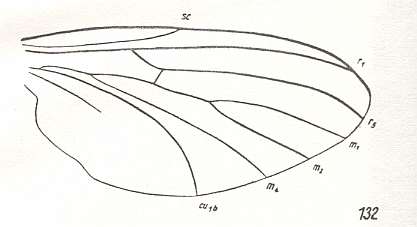
|
Eoboletina gracilis. Allactoneuridae.
Upper Jurassic of Karatau, southern Kazachstan.
Length 4.5 mm.
Radial Sector unbranched.
Replacement of Medial trunk by the cross-vein tb1 well under way (deepening of the cubital fork, stretching of the cross-vein tb1).
The venation of this fossil species may be derivable from that of the previous one (Lycoriomimodes), but the presence of 1A and the long Radius may point to an origin independent of it.
|
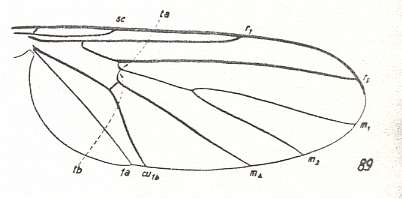
|
Diadocidia ferruginea. Diadocidiidae.
In this recent form the replacement of the Medial trunk by the stretching tb1 has not even begun.
Radial Sector unbranched.
1A ending up in wing-margin close to CuA (Cu1b in the Figure).
|
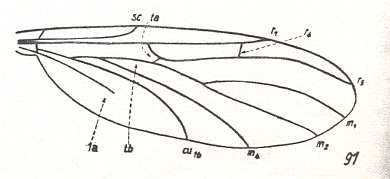
|
Pterogymnus elongata. Diadocidiidae.
Here the Radial Sector is 2-branched again. Replacement of the vanished Medial trunk by the cross-vein tb1 under way. The cross-vein ta [= r-m] not stretched out.
1A by far not reaching wing-margin.
We might say : "although RS is still 2-branched, the replacement of the vanished Medial trunk is already under way", which means that reduction of RS is not connected with that replacement. The two processes are independent of each other.
|
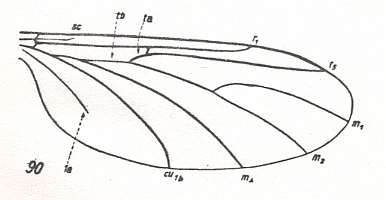
|
Heterotricha relicta. Diadocidiidae.
Radial Sector unbranched. Here also the replacement of the vanished Medial trunk by the cross-vein tb1, which is stretched out, is under way. Also the cross-vein ta [= r-m] is a little stretched out.
1A by far not reaching wing-margin.
The venation of this species can be derived from that of the previous-previous one (Diadocidia ferruginea) : SC reduced, base of RS has become very short, crossvein-like, ta-tb1-tb2 stretched out, 1A shortened. However, this is not a case of direct derivation, one from the other. Rather it is to be expected that both venations come from more or less different pre-stages, and, moreover, the fact that they belong to two different genera lets us expect specialization-crossings to be present between the two, forbidding direct derivation of the one whole species from the other.
The venation of the present species might also be derived from that of the previous one (Pterogymnus), but also here we have two different genera. Obviously, we here have a case of isolated derivability of two venations, while this derivability probably is not the result of actual derivation (in the Implicate Order) of the one from the other.
|
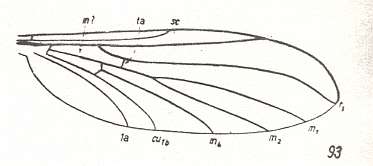
|
Arachnocampa luminosa. ?Bolitophilidae.
Radial Sector unbranched. Medial trunk apparently present.
1A reaching wing-margin.
This species should considered to be an isolated representative of the Fungivoriformia.
|
Entering now the first terminal series of the true Fungivoriformia :
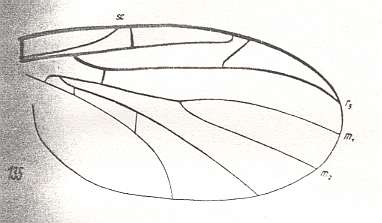
|
Transversiplecia transversinervis. Pleciofungivoridae.
Upper Jurassic of Karatau, southern Kazachstan. Length 3.5 mm. Radial Sector 2-branched. Replacement of the vanished Medial trunk by the cross-vein tb1 under way.
The cross-vein ta [= r-m] not stretched out. Cross-vein tb1 heavily stretched out. Cross-vein tb2 still present.
|

|
Pleciofungivora major. Pleciofungivoridae.
Upper Jurassic of Karatau, southern Kazachstan. Length 3.00 mm. Radial Sector 2-branched. Replacement of the vanished Medial trunk by the cross-vein tb1 (and tb2) completed.
|

|
Bolitophila hybrida. Bolitophilidae.
Radial Sector 2-branched. Replacement of the vanished Medial trunk by the cross-vein tb1 still under way, but apparently in some different way, because it seems that a trace of the original trunk is still present.
The cross-vein ta [= r-m] not stretched out. Cross-vein tb1 heavily stretched out. Cross-vein tb2 still present.
1A reaching wing-margin.
|
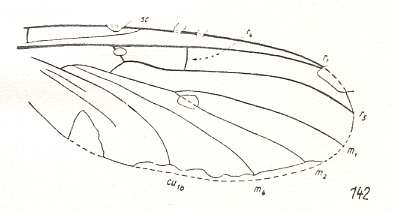
|
Mesosciophilodes angustipennis. Allactoneuridae, subfamily Mesosciophilinae.
Upper Jurassic of Karatau, southern Kazachstan. Length 4.0 mm. Radial Sector 2-branched. Its anterior branch ending up in R. Replacement of the vanished Medial trunk by the cross-vein tb1 under way.
The cross-vein ta [= r-m] not stretched out. Cross-vein tb1 heavily stretched out. Cross-vein tb2 still present.
1A not reaching wing-margin.
|
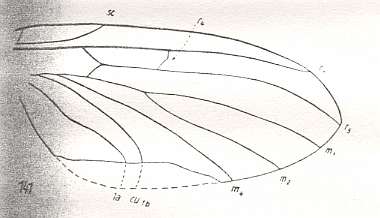
|
Mesosciophila venosa. Allactoneuridae.
Upper Jurassic of Karatau, southern Kazachstan. Length 4.5 mm. Radial Sector 2-branched. Its first branch is short and ends up in R. Replacement of the vanished Medial trunk by the cross-vein tb1 under way.
The cross-vein ta [= r-m] not stretched out. Cross-vein tb1 heavily stretched out. Cross-vein tb2 still present, stretched out.
|
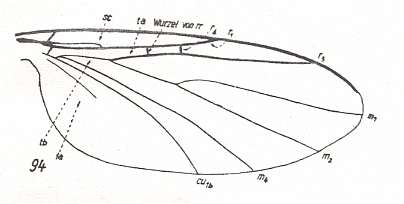
|
Ectrepesthoneura hirta. Sciophilidae.
Here the Radial Sector is still 2-branched. Its upper branch is, however, very short and crossvein-like. It ends up in R [= R1 = r1 ].
Base of RS crossvein-like. Replacement of the vanished Medial trunk by the cross-vein tb1 well under way (almost completed).
The cross-veins ta [= r-m] and tb1 heavily stretched out. Cross-vein tb2 has moved into the base of the wing (i.e. the cubital fork has become very deep).
1A by far not reaching wing-margin.
|
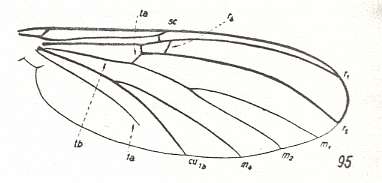
|
Mycomyia limbata. Sciophilidae.
Here the Radial Sector is still 2-branched. Its upper branch short and crossvein-like, but less so than in the previous species (Ectrepesthoneura). It ends up in R [= R1].
Replacement of the basal trunk of the Media by the cross-vein tb1 completed, but cubital fork shortened again.
The cross-vein ta [= r-m] not stretched out.
1A not reaching wing-margin.
SC in the venation of the present species in a more original state than it is in the previous species, and so forbidding strict derivability from the latter (and so does the longer 1A).
|
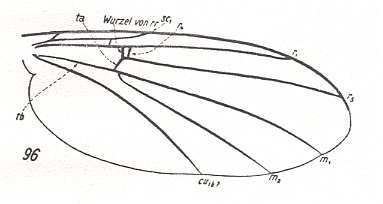
|
Monoclona forcipata. Sciophilidae.
Radial Sector is still 2-branched. Its upper branch very short and crossvein-like. It ends up in R [= R1] very close to base of RS.
M4 vanished. 1A absent.
The venation of the present species is derivable from that of the previous one (Mycomyia) : Branch of RS still closer to base of the latter, shortening of cubital fork having reached its extreme : M4 vanished, 1A completely reduced.
|
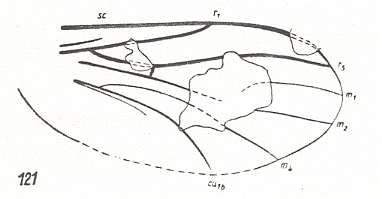
|
Paritonida brachyptera. Pleciomimidae.
Upper Jurassic of Karatau, southern Kazachstan. Length 1.75 mm. Radial Sector apparently unbranched. Replacement of the vanished Medial trunk by the cross-vein tb1 completed.
M4 present.
|
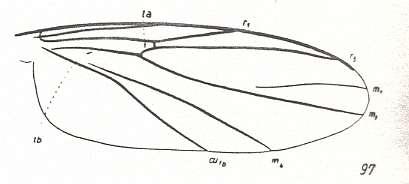
|
Rondaniella dimidiata. Sciophilidae.
Radial Sector unbranched. M4 present. 1A absent.
The venation of the present species is derived with respect to that of the previous-previous one (Monoclona) as to its Radial Sector and the direction of the cross-vein ta, but is primitive with respect to its still possessing M4. So the venation of Rondaniella cannot be derived from that of Monoclona, but it may be derivable from that of Ectrepesthoneura. Also here we have an isolated case of derivability of two venations, which derivability need not be the result of actual derivation (in the Implicate Order) of one from the other.
|
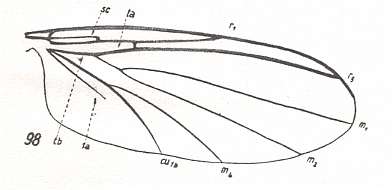
|
Docosia sciarina. Sciophilidae.
Cross-vein ta stretched. M4 present. 1A present, not reaching wing-margin.
Because of its long fork of M1+M2 the venation of the present species cannot be derived from that of Rondaniella, but it can be derived from that of Ectrepesthoneura. So we here have two more or less different venations (Docosia and Rondaniella) both derivable from that of Ectrepesthoneura, which therefore isn't much more than again an isolated case of derivability, not being the result of actual derivation.
|
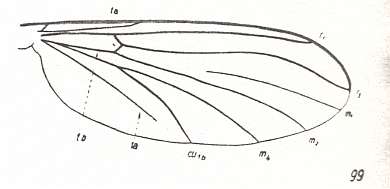
|
Neurotelia nemoralis. Sciophilidae.
Cross-vein ta not stretched. M4 present. 1A present, not reaching wing-margin.
The primitive state of ta forbids derivability of the venation of this species from that of the previous one (Docosia)
|
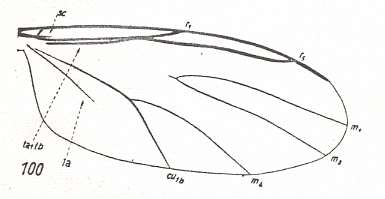
|
Novakia scatopsiformis. Sciophilidae.
ta + tb1 + RS forming one vein. Base of RS suppressed.
The venation of the present species may be derivable from that of the previous-previous one (Docosia).
|
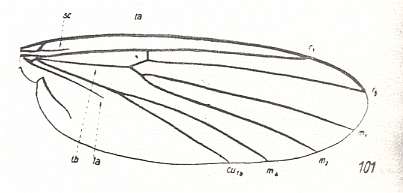
|
Fungivora fungorum. Fungivoridae.
Radial Sector unbranched.
ta oblique. Base of RS not suppressed.
The venation of this species is at best derivable from that of Mycomyia, but resisted by its long M1+M2 fork.
|
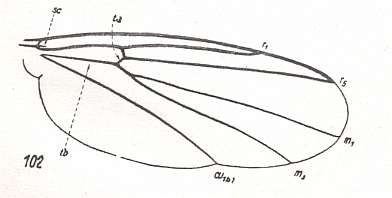
|
Zygomyia notata. Fungivoridae.
Radial Sector unbranched.
M4 absent. 1A absent.
The venation of this species is derivable from that of Fungivora. But the fact that they belong to different genera lets one expect that this derivability is not the result of actual derivation (in the Implicate Order).
|

|
Lycoria bicolor. Lycoriidae.
Radial Sector unbranched.
Cross-vein ta stretched out, forming one vein with RS. Base of RS very short, crossvein-like.
M4 present. Cubital fork deep again. 1A present, but short and very weak.
The venation of this species is best derivable from that of Ectrepesthoneura. So these venations not only belong to representatives of different genera, but also of different families (Lycoriidae, Sciophilidae), and specialization-crossings in features other than wing-venation can therefore be expected, forbidding the derivation of the species (i.e. of Lycoria bicolor from Ectrepesthoneura hirta).
|
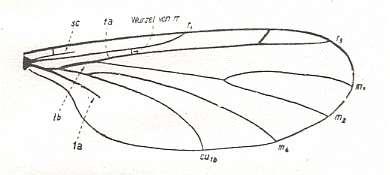
|
Cratyna spec. Lycoriidae.
It is instructive to know that a lost branch may return : RS is again 2-branched.
|
As is clearly visible, specialization-crossings abound in the above derivational series of Fungivoriformia. So we really do not have a genuine derivational line. But it can, nevertheless, seen as one, because it clearly shows the steps in the venational transformation in especially the Medial-Cubital area of the wing. There we see by what venational elements the vanished Medial trunk is being replaced. So it is as in all empirically determined (venational) derivational lines : although not representing a line of strict and complete derivations of one venation from another, it provides insight into what derivational transformations may actually have taken place, not in the Explicate Order, but in the Implicate Order, that is, in the noëtic histories ( [venational] morphoklines) of the individual species composing the derivational line.
Before we set up the corresponding diagram of morphoklines of our derivational Line 1, we consider possible different types of such diagrams, because our derivational Line 1 introduces a new type (i.e. in addition to (1) the, up to now, usual one -- semi-independent noëtic development -- and (2) the parallel noëtic development). And yet another type may be added to these, the mixed type. Let us generally characterize these four types.
The whole derivational Line 1 is globally characterized by :
- Vanishing of the basal M-trunk.
- Reduction of RS from three- to unbranched.
- Replacement of the vanished M-trunk by the cross-vein tb1.
Because of the many specialization-crossings present in our derivational Line we may safely assume that not only each of these processes took place independently of one another, but also that each one took place repeatedly in different morphoklines. But in our derivational Line the degree of independence is greater still. The next four (3+1) types of diagrams of morphoklines illustrate this :
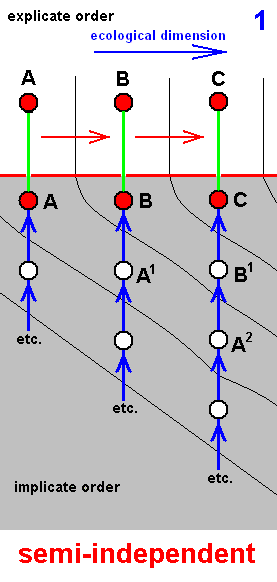
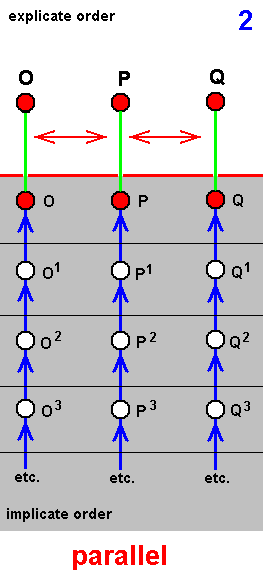
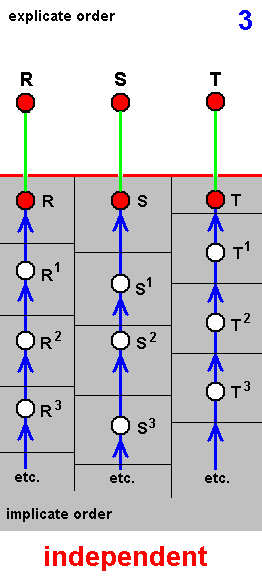
Diagram 1 : Here it is the case that, for instance, C, although, in the Explicate Order, being more or less derivable from B, is, in the Implicate Order, strictly derived not from B but from from B1. There exists, however, still some relationship between C and B because B1 is similar B. So we may call these morphoklines semi-independent.
Diagram 2 : Here it is supposed to be the case that O, P, and Q are, in the Explicate Order strictly derivable from each other. But although they are so derivable, they are, in the Implicate Order, not actually d e r i v e d from each other, but have noëtically developed in complete parallel, i.e. independently from one another. They form separate morphoklines. And although O, P, and Q do differ in some degree from each other [otherwise they could not separately exist in the Implicate Order), the transformations they have each for themselves undergone in the Implicate Order, are identical, that is, the three transformational series -- O3==>O2==>O1==>O, -- P3==>P2==>P1==>P, and -- Q3==>Q2==>Q1==>Q, are identical, but nevertheless took place in a slightly different internal qualitative context guaranteeing their being three separate morphoklines. So here we have three identical transformational series all leading -- with respect to what has been transformed -- to the same end-result. We may call these morphoklines parallel.
Diagram 3 : Here we have a case that is more or less similar to that of Diagram 2. It is similar to it by the fact that there are no cross-relations (as in Diagram 1), that is, the morphoklines are completely independent of each other. It differs, however, from Diagram 2 by the here supposed fact that the three transformational series, expressed by the three morphoklines, are not identical. They are at most more or less similar to each other by the fact that certain transformational tendencies exist in all three of them. The three morphoklines do not end up with the same result. We may call these morphoklines independent.
The latter case must, of course be distinguished from that of "totally independent development" of two or more given series, such as the noëtic development of a species of butterfly as being totally independent of that of a mammal, or of that of an oak species for that matter. And it is this type of diagram of morphoklines, exemplified by Diagram 3, that is appropriate to display the nature of the morphoklines associated with our derivational Line covering the first two series of Fungivoriformia.
Now, the fourth type :
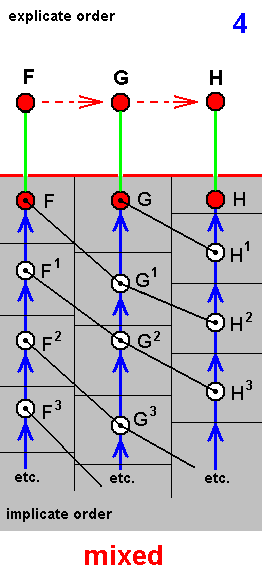
Diagram 4 : Here, finally, we have the case that is, like the previous one, more or less similar to that of Diagram 2, but, in contrast to the case depicted in Diagram 3, there do exist cross-relations between the rows of noëtic descent, making this case also similar to that in diagram 1. In a case like this it is supposed that, in sprite of the cross-relations, the rows of noëtic descent are independent of one another, because (as is supposed here) that is found to be generally the case in the more comprehensive (larger) group of which the species of the case-4 diagram of morphoklines are just a part. So although, for example G has noëtically been derived from G1, the latter looks like F, without, however, this similarity having anything to do with an alleged similar noëtic formation of G1 from G2 on the one hand, and that of F from F 1 on the other, i.e. without this similarity being the result of the alleged (noëtic) transition from the same zone of existential conditions to the next zone (as in Diagram 1). We will meet this 4th type in the diagram of morphoklines of derivational Line 1 embedded in its overall 3rd type.
Again, in the next diagram of morphoklines, i.e. that of derivational Line 1, a species of that line is represented by its genus name (unless there are more species of the same genus), and is symbolized by a letter (beginning with A, B. C, etc., and, after Z continuing with a, b, c, etc. ). The families, represented by these species, are indicated by different colors of the columns). The reader may click on the genus-names placed above the diagrams to visit the corresponding places in the Derivational Line. Because of its length, the diagram will be given as a series of six consecutive parts :
Rhaetomyia Axymyia Pachyneura Paraxymyia Perissomma Mycetobia Ditomyia fasc. Ditomyia conj.
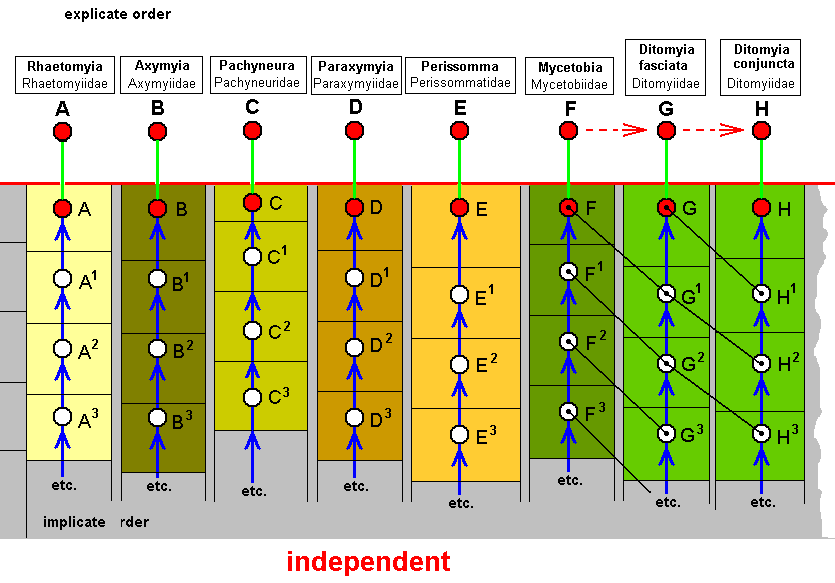
Maxrocera Zelmira Allactoneura Apemon Pleciomimella Pleciomima Mimallactoneura
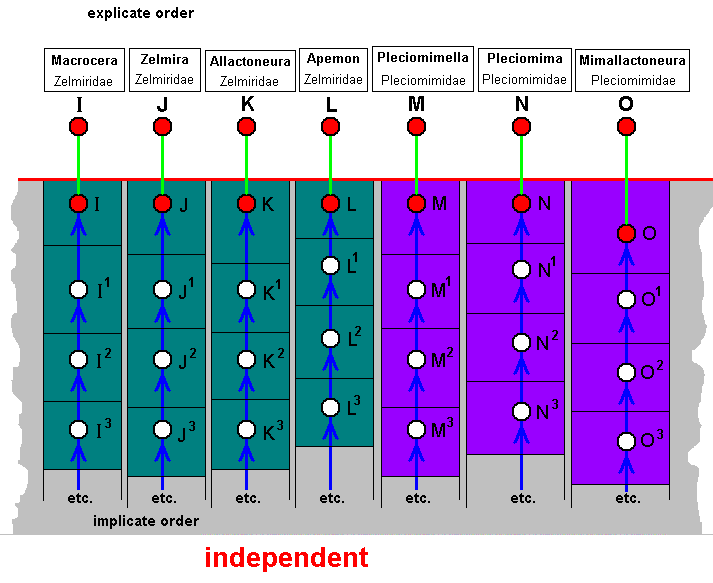
Lycoriomimodes Eoboletina Diadocidia Pterogymnus Heterotricha Arachnocampa Transversiplecia
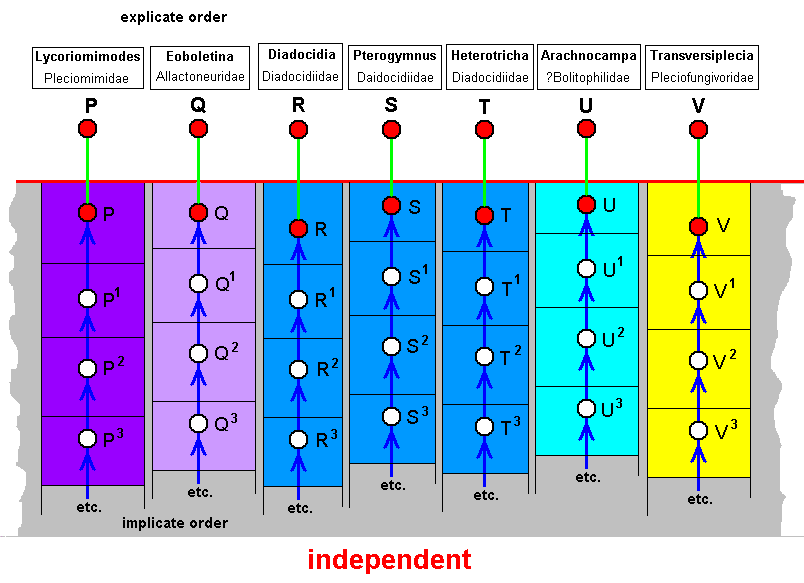
Pleciofungivora Bolitophila Mesoscioplilodes Mesosciophila Ectrepesthoneura Mycomyia Monoclona
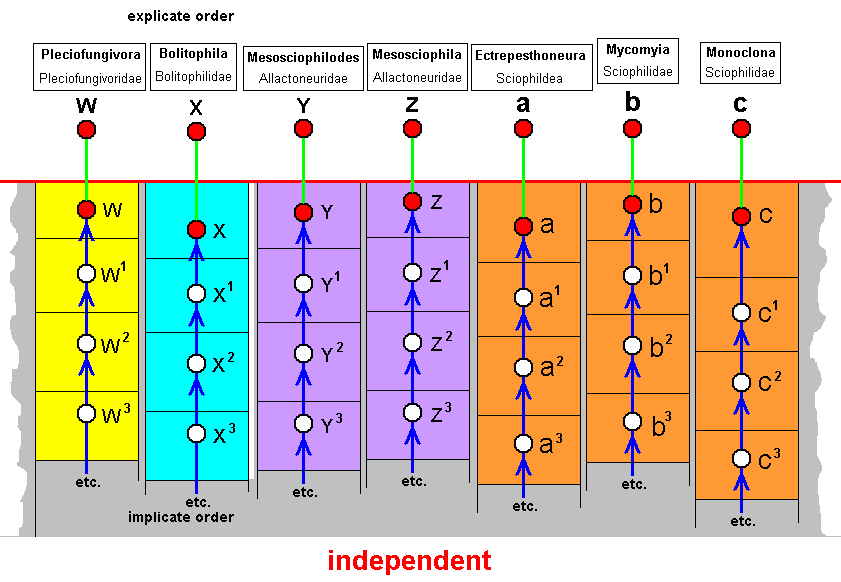
Paritonida Rondaniella Docosia Neurotelia Novakia Fungivora Zygomyia
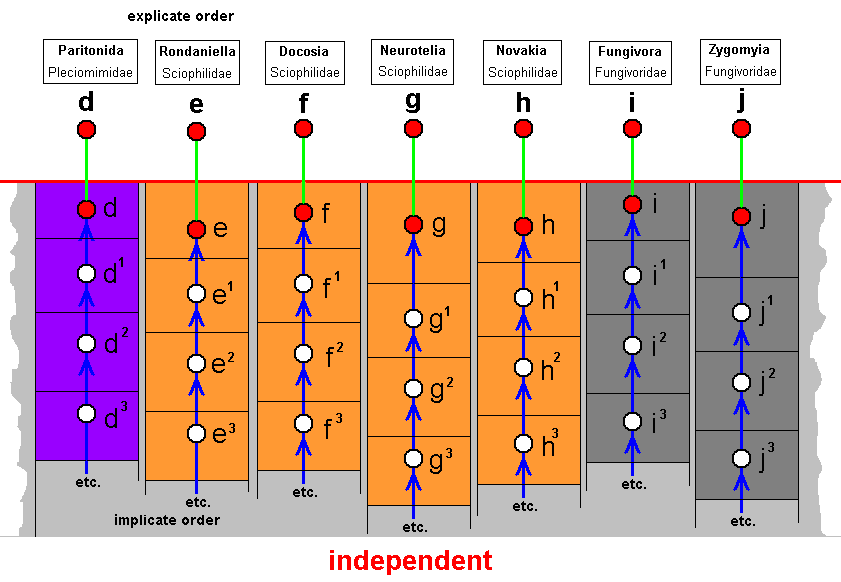
Lycoria Cratyna
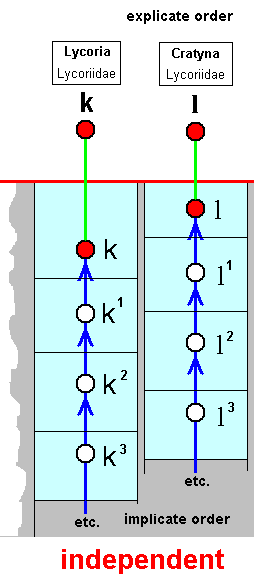
End of series of morphoklines associated with derivational Line 1.
* * *
Derivational Line 2 (basic series + second terminal series of the true Fungivoriformia)
( Without indication of geological age : representative of recent fauna. The basal part of this Line [Pachyneuridae--Diadocidiidae] is common to that of the previous Line, so we here start with Diadocidia [see Overview of phylogenetic system of the recent Fungivoriformia, given above ] and then continue with : Corynoscelidae, Scatopsidae and Itonididae ) (See for this the last fourth of Part XXVIII ) :

|
Diadocidia ferruginea. Diadocidiidae.
Subcosta developed. Radial Sector unbranched.
The cross-veins ta [= r-m], tb1 [= basal section of M4], and tb2 [= m-cu] [see for the original configuration of this region HERE ] still in their position and orientation as true cross-veins (tb2 and ta) or base of longitudinal branch (tb1).
In this recent form the replacement of the Medial trunk by the stretching tb1 has not even begun (while we saw it already in fossils). M1, M2, and M4 present.
1A ending up in wing-margin close to CuA (Cu1b in the Figure).
|
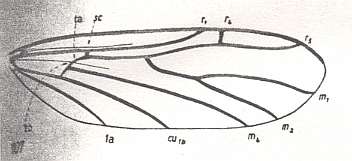
|
Corynoscelis eximia. Corynoscelidae.
Radial Sector 2-branched.
Subcosta long, but not reaching the wing-margin or R1.
The basal trunk of the Media is weak. It is not replaced by tb1 or ta.
M1, M2, and M4 present. ta, tb1, and tb2 together forming more or less one vein.
Because M1+2 originates from RS, we might take the cross-vein ta to be suppressed.
The vein 1A fully developed, reaching wing-margin.
Although things are already happening in the Cubital-Medial region (especially the aligning of tb1 with tb2 and the deepening of the cubital fork), the Radial Sector is 2-branched, forbidding to derive the present form out of the previous one (Diadocidia).
|
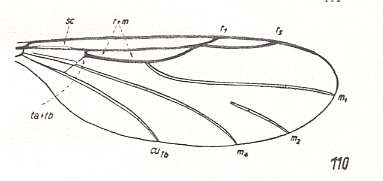
|
Synneuron annulipes. Corynoscelidae.
SC short, ending up in R1. Radial Sector has become unbranched as a result of the suppression of its first branch. The cubital fork is still present (i.e. tb2 and M4 are still present) and deep. Also the basal trunk of the Media is present, although, it seems, weakened. The cross-vein ta being suppressed or not, tb1 still present as a true cross-vein, meaning that the trunk of M has not been replaced [by tb1]. Basal section of M2 reduced. 1A absent.
The venation of the present form can be derived from that of the previous one (Corynoscelis).
|
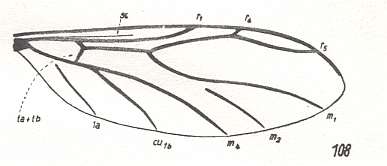
|
Canthyloscelis antennata. Corynoscelidae.
Radial Sector still 2-branched. ta and tb1 forming one single vein (except when we consider ta to be suppressed).
Here the basal trunk of the Media has vanished, but not yet been replaced.
M2 in a reduced condition. 1A present.
What we here had called "one single vein" may be just tb1. And it seems that the cubital fork is shortening again, resulting in tb2 [= m-cu] not having the face of a cross-vein anymore, but having integrated with M4.
Because of its Radial Sector being 2-branched, the venation of this species cannot be derived from that of the previous one (Synneuron) (RS unbranched). With respect to the shortened cubital fork it is isolated from the other two forms (Corynoscelis and Synneuron).
|

|
Scatopse fuscipes. Scatopsidae.
SC completely reduced. RS unbranched. Base of RS short, crossvein-like.
The cross-vein ta still has its original position and orientation. But the cross-vein tb1 has assumed a horizontal orientation as a result of the deepening of the cubital fork. M1, M2, and M4 present. 1A absent.
|
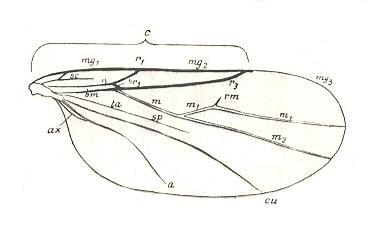
|
Scatopse lapponica. Scatopsidae.
(Venational interpretation in the the Figure according to its author (Duda), but not followed here)
c = Costa. Subcosta developed, but ending blindly. Base of RS short. Radial Sector unbranched. Cross-vein ta almost suppressed. What is left, drawn out horizontally.
M1, M2, and M4 present [the vein M4 in the Figure labelled as "Cu"]. CuA [in the Figure labelled "a"] present, long, almost reaching wing-margin. Cubital fork (= CuA + M4) very deep. As a result of this deepening, the cross-vein tb1 is drawn out horizontally, and in this way replacing the vanished M-trunk. Vein 1A absent (or rudimentary).
|
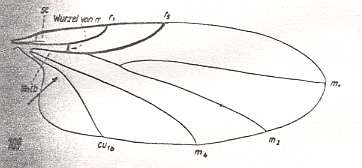
|
Ectaetia clavipes. Scatopsidae.
Subcosta almost completely reduced. RS unbranched.
The cross-vein ta either has been suppressed or has changed its usual orientation : from oblique to horizontal. Its proximal extension is formed by the cross-vein tb1 which is also horizontal as a result of the deepening of the cubital fork.
The basal piece of the common stalk of M1 and M2 has coalesced with the Radial Sector, as we saw it already above in the Corynoscelidae.
The course and position of the Radial Sector in (1) the present species, in (2) Scatopse lapponica (previous form), and in (3) Scatopse fuscipes (previous-previous form) oppose seeing them as a true derivational series.
|
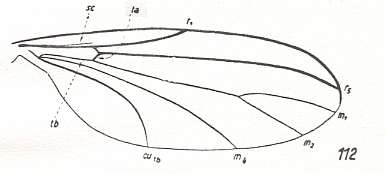
|
Catocha spec. Lestremiidae ( Itonididea [= Cecidomyiidea] ).
Subcosta strongly reduced. Radial Sector unbranched. The cross-vein ta is still in its original position and orientation, that is, it makes a clear angle with the Radial Sector.
The cubital fork is deepened, causing the cross-vein tb1 to assume a horizontal orientation and replace the vanished M-trunk.
Although the venation of the present form is similar to that of Scatopse fuscipes , the position and course of R and RS in these forms forbid them to be derivationally related to each other.
|
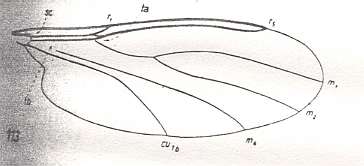
|
Lestremia cinerea. Lestremiidae ( Itonididea [= Cecidomyiidea] ).
Subcosta extremely short. The cross-vein ta has assumed an almost horizontal position, and is very short. It forms the proximal extension of the Radial Sector. The rest of this extension is formed by the cross-vein tb1 which runs horizontally, close to and parallel with, the Radius. The connection between M4 and Cu1b [= CuA] is severed.
The present form can be derived from the previous one (Catocha), but does not lead to the next one (Tetraxyphus).
|
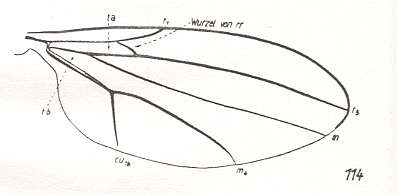
|
Tetraxyphus atra. Itonididae [= Cecidomyiidae] ).
Subcosta absent. RS unbranched. The cross-vein ta clearly has assumed a horizontal orientation, and its proximal extension is formed by the cross-vein tb1 which also runs horizontally, probably as a result of an initial deepening of the cubital fork. In the present form this deepening is followed by a secondary shallowing of this fork as a result of partial coalescence of its two branches.
Apart from the presence of M4, the Media is unbranched.
In the present form the vein R5 assumes a quite different position in the wing than it does in the wing of the previous form (Lestremia), indicating that they cannot be closely related (as to their qualitative content) to each other.
|
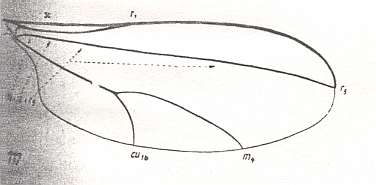
|
Asphondylia sarothamni. Itonididae [= Cecidomyiidae] ).
Subcosta absent. The vein running far below the Radius (R1) is composed in the same way as in Lasioptera? (next form) : It consists of (1) the Radial Sector (here, R5), which has lost its connection with R1, (2) the cross-vein ta, and (3) the cross-vein tb1, but it is still quite long and reaches the apex of the wing.
M1+2, and also its branches M1 and M2, have vanished.
|
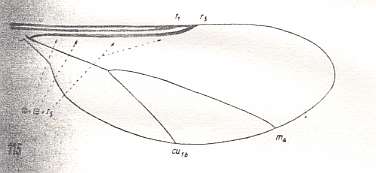
|
Lasioptera? flexuosa. Itonididae [= Cecidomyiidae] ).
Subcosta absent. Below the Radius (= R1 = r1), parallel and very close to it, we see a single strong longitudinal vein. This vein, long in the previous form, consists of (1) the Radial Sector (here, R5), which has lost its connection with R1, (2) the cross-vein ta, and (3) the cross-vein tb1.
The vein M1+2, and also its branches M1 and M2, have, like in the previous form, vanished.
Cubital fork (CuA + M4) a little deepened again.
|
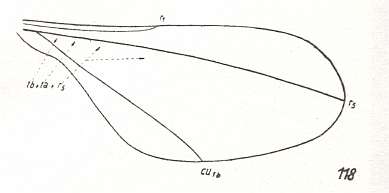
|
Miastor hastatus. Itonididae [= Cecidomyiidae] ).
Radial Sector still long, reaching wing-apex. All Medial veins, including M4, vanished (so the cubital fork is absent). Apart from the Costa (if present at all), the wing has only three veins : Radius (R1), Radial Sector (R5), and the Cubitus (Cu1b [= CuA] ).
The second vein (R5) might, however, not be the Radial Sector at all, but M4. If that is the case, we assume that R5 has either coalesced witt R1 or disappeared altogether, and that the cubital fork (CuA+M4) has deepened still further. And indeed, this interpretation seems to me the better one.
Accordingly, the itonidid series Tetraxyphus ==> Asphondylia ==> Lasioptera ==>Miastor forms a true derivational series.
|
The corresponding diagram of morphoklines of derivational Line 2 (present document) will, because of its size, also be presented as (two) consecutive diagrams (again, the reader may click on the genus names to see the corresponding venations in the derivational Line) :
Diadocidia Corynoscelis Synneuron Canthyloscelis Scatopse fuscipes Scatopse lapponica Ectaetia
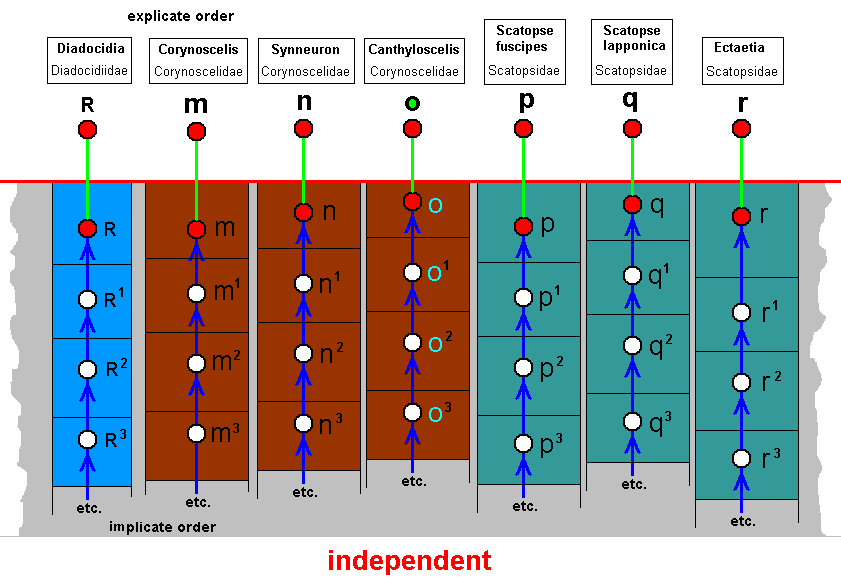
Catocha Lestremia Tetraxyphus Asphondylia Lasioptera Miastor
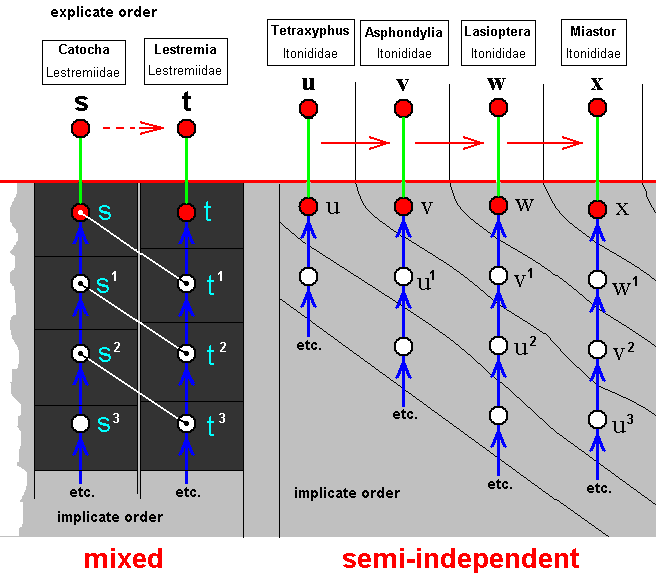
* * *
We have now concluded the (true) Fungivoriformia (and with them all Bibionomorpha) as to derivational lines and morphoklines, that is to say, we have treated them according to the polyphyletic (and also noëtic) theory of evolution. What we actually 'see' in the Explicate Order is the consecutive appearance of the various species and with them of the different types they represent.
Projection of these into the Explicate Order depends upon the actual existence of appropriate ecological existential conditions in the latter Order. And because the chief ecological factors are the biotic ones, i.e. the presence of the various organisms (plants and animals), a given to-be-projected strategy/species presupposes the actual existence -- in the Explicate Order -- of precisely those other organisms that play an integral part in the very content of the strategy. This means that the other organisms that the strategy/species intrinsically needs in order to be able to materially exist, must be present in the Explicate Order. Organisms against which the projected strategy/species is adapted to defend itself need not, of course, be present. So we may safely hold that the order of appearance -- in the Explicate Order -- of organismic species reflects the development, in the Explicate Order, of ecological existential conditions, where the appearing species take part in that development while at the same time presupposing the existence of other species (in already existing ecological conditions). So, again, what we in fact 'see' in the Explicate Order is an ordered appearance (accompanied by extinctions) of organismic species and types, which [order of appearance] one then interprets as "evolution", because in conventional theory it is assumed that later species have evolved from earlier ones. According to our theory, however, genuine evolution takes place only in the Implicate Order. But because it takes place there in a timeless fashion, it is in fact not evolution but derivation of one stage from another as a result of (timeless) noëtic reactions. And it is, in the later documents of this website, supposed that this noëtic evolution is completely polyphyletic. Every fully-fledged strategy has noëtically evolved from its own starting point in the Implicate Order. Its development there is driven by the 'aspiration' to become ontologically complete. And it is so completed when it materially exists in the Explicate Order.
In the next document we will continue with the exposition of still more functional wing-types, namely those of the rest of the Order Diptera, that is, mainly from the suborders Brachycera-orthorrapha and Brachycera-cyclorrapha (which we had not yet done in earlier documents).
e-mail :  ( Please write in ' Subject ' entry : ' METAPHYSICS ', in order for me to be able to distinguish your mail from spam )
( Please write in ' Subject ' entry : ' METAPHYSICS ', in order for me to be able to distinguish your mail from spam )
To continue click HERE for further study of Organic Evolution, Part LXXI.
Back to Homepage
Back to Contents
Back to Evolutionary Part XIV
Back to Evolutionary Part XV
Back to Evolutionary Part XVI
Back to Evolutionary Part XVII
Back to Evolutionary Part XVIII
Back to Evolutionary Part XIX
Back to Evolutionary Part XX
Back to Evolutionary Part XXI
Back to Evolutionary Part XXII
Back to Evolutionary Part XXIII
Back to Evolutionary Part XXIV
Back to Evolutionary Part XXV-A
Back to Evolutionary Part XXV-B
Back to Evolutionary Part XXV-C
Back to Evolutionary Part XXVI
Back to Evolutionary Part XXVII
Back to Evolutionary Part XXVIII
Back to Evolutionary Part XXVIII-A
Back to Evolutionary Part XXIX
Back to Evolutionary Part XXX
Back to Evolutionary Part XXXI
Back to Evolutionary Part XXXII
Back to Evolutionary Part XXXIII
Back to Evolutionary Part XXXIV
Back to Evolutionary Part XXXV
Back to Evolutionary Part XXXVI
Back to Evolutionary Part XXXVII
Back to Evolutionary Part XXXVIII
Back to Evolutionary Part XXXIX
Back to Evolutionary Part XL
Back to Evolutionary Part XLI
Back to Evolutionary Part XLII
Back to Evolutionary Part XLIII
Back to Evolutionary Part XLIV
Back to Evolutionary Part XLV
Back to Evolutionary Part XLVI
Back to Evolutionary Part XLVII
Back to Evolutionary Part XLVIII
Back to Evolutionary Part XLIX
Back to Evolutionary Part L
Back to Evolutionary Part LI
Back to Evolutionary Part LII
Back to Evolutionary Part LIII
Back to Evolutionary Part LIV
Back to Evolutionary Part LV
Back to Evolutionary Part LVI
Back to Evolutionary Part LVII
Back to Evolutionary Part LVIII
Back to Evolutionary Part LIX
Back to Evolutionary Part LXa
Back to Evolutionary Part LXb
Back to Evolutionary Part LXc
Back to Evolutionary Part LXI
Back to Evolutionary Part LXII
Back to Evolutionary Part LXIII
Back to Evolutionary Part LXIV
Back to Evolutionary Part LXV
Back to Evolutionary Part LXVI
Back to Evolutionary Part LXVII
Back to Evolutionary Part LXVIII
Back to Evolutionary Part LXIX
Back to Evolutionary Part LXIXa
Back to Evolutionary Part LXIXb
Back to Evolutionary Part LXX
Back to Evolutionary Part LXXa




























 ( Please write in ' Subject ' entry : ' METAPHYSICS ', in order for me to be able to distinguish your mail from spam )
( Please write in ' Subject ' entry : ' METAPHYSICS ', in order for me to be able to distinguish your mail from spam )